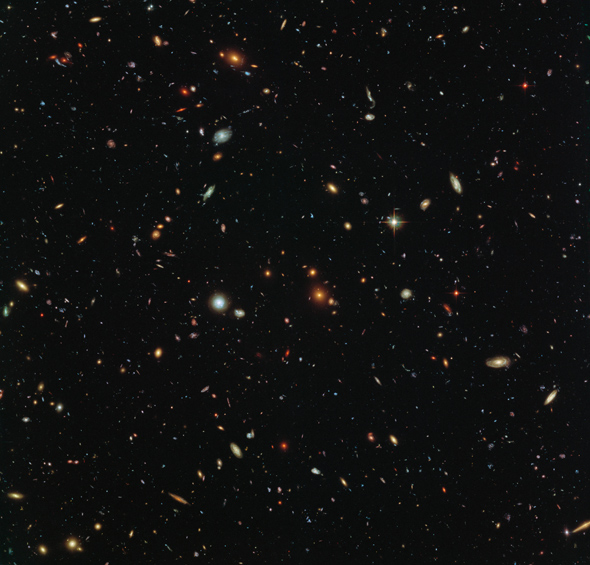There were several interesting articles and images that all gave me the inspiration for this post. So, let’s talk about the idea of life in our universe beyond our solar system.
The first question to think about is how many other planets are there. The answer is lots. No, “lots” doesn’t even begin to cover it. I got this image from NASA (click the image to the source… it’s big).

Phil Plait, over at Bad Astronomy did a calculation to determine just how many galaxies Hubble could see. Note that isn’t all the galaxies in the universe, just the ones the Hubble Space Telescope could potentially see.
First he calculated how many galaxies were in a small piece of the above image. It’s about 50. That piece was 1/100 of the actual image. So, the image above contains about 5,000 galaxies.
Then he found out that the image is 10 square arcminutes. The entire sky is about 150 million square arcminutes, which means that there are about 15,000,000 pieces of sky the same size as the above image. At roughly 5,000 galaxies per, we get a total of 75,000,000,000 galaxies. That’s 75 billion visible galaxies with the Hubble.
The Milky Way has about 100 billion stars (though some estimates approach 400 billion). If we assume that an average galaxy has 100 billion stars, which is fairly safe, then we get 100 billion * 75 billion stars in the universe.
That is 7,500,000,000,000,000,000,000 or 7.7×1021 stars.
How many could potentially support life? Well, a lot depends on A) how you define life and B) what conditions we consider for that life.
Right now, we know of only one planet that unambiguously has life. There is significant potential for life elsewhere in our solar system. Though it would likely be limited to the bacteria level or extraterrestrial equivalent. Still, if we find life on Europa, Titan, Enceladus, or even Mars, then the options for life on extrasolar planets just got even better.
But let’s talk about that life on other planets. How would life appear?
Well, that’s an entire topic of research called Origins of Life (OOL). The results are very impressive so far. There are multiple ways to get the basic organic compounds needed for life, without life needing to be present. One of the main sticking points has been ribose sugars, the main component in the backbone of DNA and RNA. Some new research suggests that is much less of a sticking point than previously thought.
Cornelia Meinert (Meinert 2016) and her team discovered that a relatively simple reaction, catalyzed by ultraviolet light, forms ribose and a variety of other sugars… in space.
Ice is common in space, we regularly track large balls of space ice and even landed on one of them. So, that’s water. Another needed component is ammonia, which seems to be common in space as well. Finally, we need a source of carbon and that comes from methanol (methyl alcohol). Which is, you guessed it, common in deep space. These are all inorganic sources of these materials, no life required.
The idea behind the paper is that a planetary nebula, that is a pre-solar system, has all these materials much more scattered than in a solar system with planets. There’s a lot of supporting evidence for this in our own solar system.
In our solar system, excluding the sun, Jupiter has 3 times the mass of every other planet combined. It has methane, ammonia (including ammonia ice), even benzene rings (link to Voyager probe results). So, in a pre-planetary nebula, all of these compounds would be present.
Much like the famous Miller-Urey experiment, the researchers took these compounds, exposed them to near space temperatures (78 Kelvin, which is -319 F), hit them with UV light, then warmed them up. The result was 56 unique compounds (not including the isomers of those compounds), most of which, we would think required life to manufacture.
The question then becomes, how did the material formed in space get to Earth. That’s where the Late-Heavy Bombardment comes in. The hypothesis is that between 4.1 and 3.8 billion years ago, the inner planets underwent a very heavy period of asteroid and comet impacts. The suggested impacts are stunning. By extrapolating lunar impacts to Earth, the estimate is over 20,000 impacts large enough to form a 20 kilometer diameter crater. As an example, Meteor Crater in Arizona is just over 1 kilometer in diameter.
Larger impacts would also have happened, including multiple impacts resulting in 5,000 kilometer craters.
This is in addition to other research about the common origin of RNA, lipids, and proteins.
The point is, we find these compounds all over the universe. And the universe is truly immense. It is the height of arrogance to assume that life only exists on Earth and that humans are the only intelligent species in the universe.
Now, a discussion about whether we would ever find that other life is a totally different prospect. But even with one planet per galaxy with life, that’s 75 billion planets with life in our universe.
___________________________________________
Meinert, C, Myrgorodska, I & Marcellus, D. P. Ribose and related sugars from ultraviolet irradiation of interstellar ice analogs. … (2016). doi:10.1126/science.aad8137
